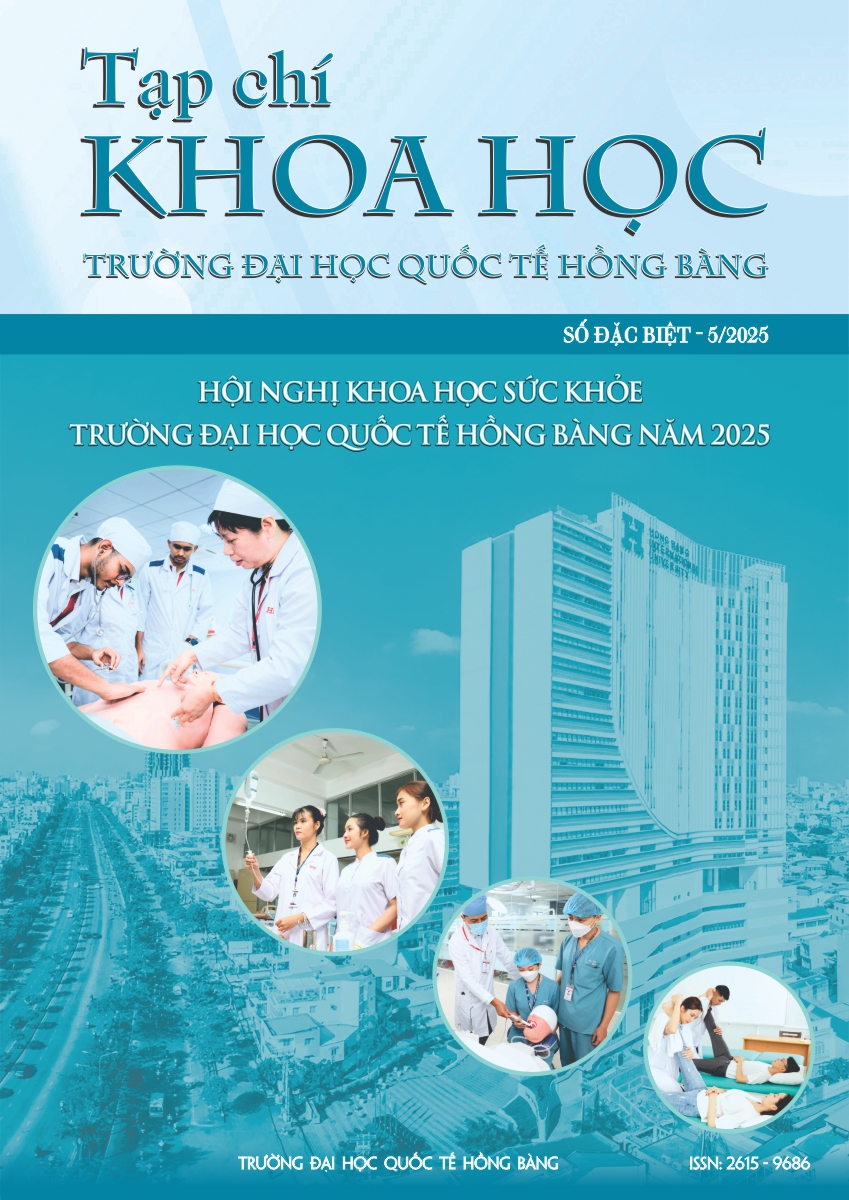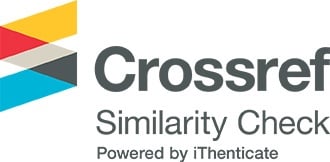XÂY DỰNG VÀ THẨM ĐỊNH QUY TRÌNH ĐỊNH LƯỢNG EDTA TRONG MAYONNAISE BẰNG PHƯƠNG PHÁP HPLC-UV
Các tác giả
DOI: https://doi.org/10.59294/HIUJS.KHSK.2025.027Từ khóa:
định lượng EDTA, mayonnaise, HPLC-UV, tạo phức Fe(III), phân tích phụ gia thực phẩmTóm tắt
EDTA thường được sử dụng trong thực phẩm dưới dạng các muối disodium (Na2H2EDTA) (E385) và calcium disodium (Na2CaEDTA) (E386) như là tác nhân chelat hóa kim loại nặng, làm chất ổn định màu sắc và hương vị của sản phẩm. Nghiên cứu nhằm phát triển phương pháp đơn giản, độ tin cậy cao để định lượng EDTA và dạng muối trong mayonnaise được chiết bằng nước có hỗ trợ siêu âm, sau đó tạo phức với dung dịch Fe(III). Dung dịch sau khi tạo phức với Fe(III) và được định lượng bằng HPLC-UV. Phương pháp được thẩm định khoảng tuyến tính, độ lặp lại, độ tái lặp, giới hạn phát hiện và giới hạn định lượng. Giới hạn phát hiện và giới hạn định lượng EDTA được xác định ở nồng độ 0.330 mg/L và 1.0 mg/L. Khoảng tuyến tính đạt yêu cầu R2 > 0.995 và độ thu hồi EDTA đạt từ 98.4% đến 101.6% và %RSD là 1.364% < 2.0%. Phương pháp phân tích nhanh, xử lý mẫu không quá phức tạp và thẩm định đạt yêu cầu để áp dụng phân tích EDTA trong mayonnaise.
Từ khóa: định lượng EDTA, mayonnaise, HPLC-UV, tạo phức Fe(III), phân tích phụ gia thực phẩm
Abstract
Development and Validation of a Method for Quantifying EDTA in Mayonnaise Using HPLC-UV. A simple and highly reliable method was developed for the quantification of EDTA and its salt forms in mayonnaise. Samples were extracted with water under ultrasonic assistance and subsequently complexed with Fe(III). The resulting Fe(III)- EDTA complex was quantified using high-performance liquid chromatography with UV detection (HPLC-UV). The method was validated in terms of linearity, repeatability, reproducibility, limit of detection (LOD), and limit of quantification (LOQ). The LOD and LOQ were determined to be 0.330 mg/L and 1.0 mg/L, respectively. The calibration curve exhibited excellent linearity with R² > 0.995. The method demonstrated high recovery (98.4%-101.6%) and acceptable repeatability (RSD = 1.364% < 2.0%). This approach provides a rapid and reliable analytical method with straightforward sample preparation and satisfactory validation for the determination of EDTA in mayonnaise.
Tài liệu tham khảo
[1] R. Heydari, M. Shamsipur and N. Naleini, “Simultaneous Determination of EDTA, Sorbic Acid, and Diclofenac Sodium in Pharmaceutical Preparations Using High-Performance Liquid Chromatography”, AAPS PharmSciTech, vol. 14, no. 2, pp. 764-769, 2013.
DOI: https://doi.org/10.1208/s12249-013-9962-0[2] B. Narola, A. S. Singh, M. Mitra, P. R. Santhakumar and T. G. Chandrashekhar, “A validated reverse phase HPLC method for the determination of disodium EDTA in Meropenem drug substance with UV-Detection using Precolum Derivatization Technique”, Analytical Chemistry Insights, vol. 6, pp. 7-14, 2011.
DOI: https://doi.org/10.4137/ACI.S5953[3] B. Y tế, “Thông tư Quy định về quản lý và sử dụng phụ gia thực phẩm”, Thông tư 24/2019/TT-BYT, Hà Nội, Việt Nam, 2019.
[4] T. P. Knepper, A. Werner, and G. Bogenschütz, “Determination of synthetic chelating agents in surface and wastewater by ion chromatography-mass spectrometry”, Journal of Chromatography A, vol. 1085, no. 2, pp. 240-246, 2005.
DOI: https://doi.org/10.1016/j.chroma.2005.06.045[5] P. Kuran, D. Pilnaj, M. Dzurková, and M. Smaha, “Method development for determination of EDTA in water by using traditional split/splitless injector-comparing external and internal standard methods of quantification”, IOP Conference Series: Earth and Environmental Science, vol. 221, no. 1, p. 012126, 2019.
DOI: https://doi.org/10.1088/1755-1315/221/1/012126[6] A. K. Palakurthi and T. Dongala, “HPLC-UV method development for the determination of EDTA in oxycodone HCl oral liquids with derivatization technique: Robustness by design of experiments approach”, Analytical Chemistry Letters, vol. 9, no. 5, pp. 1-14, 2019.
DOI: https://doi.org/10.1080/22297928.2019.1674186[7] M. Sillanpää, R. Kokkonen, và M. L. Sihvonen, “Determination of EDTA and DTPA as their Fe(III) complexes in pulp and paper mill process and waste waters by liquid chromatography”, Analytica Chimica Acta, vol. 303, no. 2, pp. 187-192, 1995.
DOI: https://doi.org/10.1016/0003-2670(94)00535-T[8] C. E. Cagnasso, L. B. López, V. G. Rodríguez, và M. E. Valencia, “Development and validation of a method for the determination of EDTA in non-alcoholic drinks by HPLC”, Journal of Food Composition and Analysis, vol. 20, no. 3-4, pp. 248-251, 2007.
DOI: https://doi.org/10.1016/j.jfca.2006.05.008[9] F. Chiumiento, A. D'Aloise, F. Marchegiani, and V. Melai, “Determination of EDTA in feed and premix formulations by HPLC-DAD”, Food Chemistry, vol. 175, pp. 452-456, 15 May 2015.
DOI: https://doi.org/10.1016/j.foodchem.2014.11.159[10] D. Jin, C. Wang, X. Yue, and J. Wang, “Determination of EDTA-2Na in pickles and canned mixed congee using a fluorescent zirconium-quercetin complex”, Journal of Food Composition and Analysis, vol. 124, p. 105634, 2023.
DOI: https://doi.org/10.1016/j.jfca.2023.105634[11] B. Chandrashekhar, P. Pai, A. Morone, N. Sahu, and R.A. Pandey, “Reduction of NOx in Fe-EDTA and Fe-NTA solutions by an enriched bacterial population”, Bioresource Technology, vol. 130, pp. 644-651, 2013.
DOI: https://doi.org/10.1016/j.biortech.2012.12.051[12] Appendix F: Guidelines for Standard Method Performance Requirements, AOAC International, 2016.
Tải xuống
Tải xuống: 71











